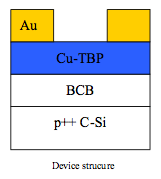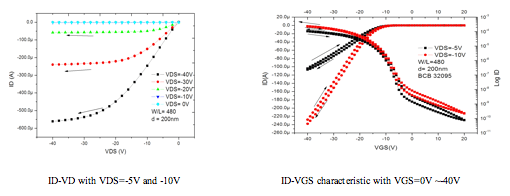
Polycrystalline Cu-Tetrabenzoporphyrin Field-Effect; Transistor with Benzocyclobutene Gate Dielectric
Albert Lin and Jerzy Kanicki
 In this work the possibility of using benzocyclobutene (BCB) as organic gate dielectric for polycrystalline metallo-porphyrin based organic field-effect transistor was investigated. Top source / drain contact device structures with the tetrabenzoporphyrin and Cu-tetrabenzoporphyrin (Cu-TBP) were fabricated in this study. The benzocyclobutene (BCB) originally developed as inter-layer dielectric for CMOS technology was used in this work as organic gate dielectric layer. Since BCB has good electrical and thermal properties (glass transition temperature >350?, resistivity ~1019 Ω-cm, breakdown field ~ 5.3×106 V/cm), and high optical transparency in most visible frequency, it appears to have a great potential as organic gate dielectric for organic thin-film transistors. In this work the possibility of using benzocyclobutene (BCB) as organic gate dielectric for polycrystalline metallo-porphyrin based organic field-effect transistor was investigated. Top source / drain contact device structures with the tetrabenzoporphyrin and Cu-tetrabenzoporphyrin (Cu-TBP) were fabricated in this study. The benzocyclobutene (BCB) originally developed as inter-layer dielectric for CMOS technology was used in this work as organic gate dielectric layer. Since BCB has good electrical and thermal properties (glass transition temperature >350?, resistivity ~1019 Ω-cm, breakdown field ~ 5.3×106 V/cm), and high optical transparency in most visible frequency, it appears to have a great potential as organic gate dielectric for organic thin-film transistors.
The thickness of spin coated BCB was about 200nm. The devices showed good electrical performance with the field-effect mobility in the range of 0.1cm2V-1sec-1 and on/off current ratio ~ 105. To evaluate the hysteresis in the drain current – gate voltage (ID-VGS) characteristics in linear region, the gate voltage swept was done from on- to off- and then back from off- to on-regions. Source electrode was set as ground (reference electrode) in these experiments. Gate to source potential is changed from -40V(on) to 20V(off) while drain-to-source potential was kept at -5V and -10V, respectively.

As a result, the holes flow from source to drain electrodes and represent the primary component of drain current. Transistor is in on-state when gate-to-source potential drops below threshold voltage (VT-=-10V), indicating that the Cu-TBP is p-type organic semiconductor and transistor is operating in so called enhancement mode. The hysteresis in Cu-TBP thin-film transistor transfer characteristics (ID-VG), the commonly observed phenomenon in organic field-effect transistor, is reduced (in comparison to thermal silicon dioxide gate dielectric) by using BCB as organic gate dielectric. Nevertheless, the threshold voltage was still about -10V, which is slightly too high and should be further reduced. The short term goal of this project is to develop fundamental understanding of the Cu-TBP / organic gate dielectric interface and its engineering for advanced device electrical performance and satability.
top
|

